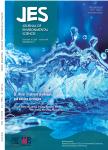Polystyrene microplastics disrupted physical barriers, microbiota composition and immune responses in the cecum of developmental Japanese quails
作者机构:College of Life SciencesShaanxi Normal UniversityXi’an 710119China
出 版 物:《Journal of Environmental Sciences》 (环境科学学报(英文版))
年 卷 期:2024年第144卷第10期
页 面:225-235页
核心收录:
学科分类:083002[工学-环境工程] 0830[工学-环境科学与工程(可授工学、理学、农学学位)] 08[工学]
基 金:The work was supported by the National Natural Science Foundation of China(No.33372201)
主 题:Microplastics Gut barrier Histology Inflammation Immunity Oxidative stress
摘 要:Microplastics,a new type of emerging pollutant,is ubiquitous in terrestrial and water *** have become a growing concern due to their impacts on the environment,animal,and human *** also suffer from microplastics *** this study,we examined the toxic effects of polystyrene microplastics(PS-MPs)exposure on physical barrier,microbial community,and immune function in the cecum of a model bird species—Japanese quail(Coturnix japonica).The one-week-old birds were fed on environmentally relevant concentrations of 20μg/kg,400μg/kg,and 8 mg/kg PS-MPs in the diet for 5 *** results showed that microplastics could cause microstructural damages characterized by lamina propria damage and epithelial cell vacuolation and ultrastructural injuries including microvilli breakage and disarrangement aswell asmitochondrial vacuolation in the cecum of *** particular,blurry tight junctions,wider desmosomes spacing,and gene expression alteration indicated cecal tight junction ***,mucous layer breakdown andmucin decrease indicated that chemical barrier was disturbed by ***-MPs also changed cecal microbial *** addition,structural deformation of cecal tonsils and increasing proinflammatory cytokines suggested cecal immune disorder and inflammation responses by PS-MPs *** results suggested that microplastics negatively affected digestive system and might pose great health risks to terrestrial birds.



